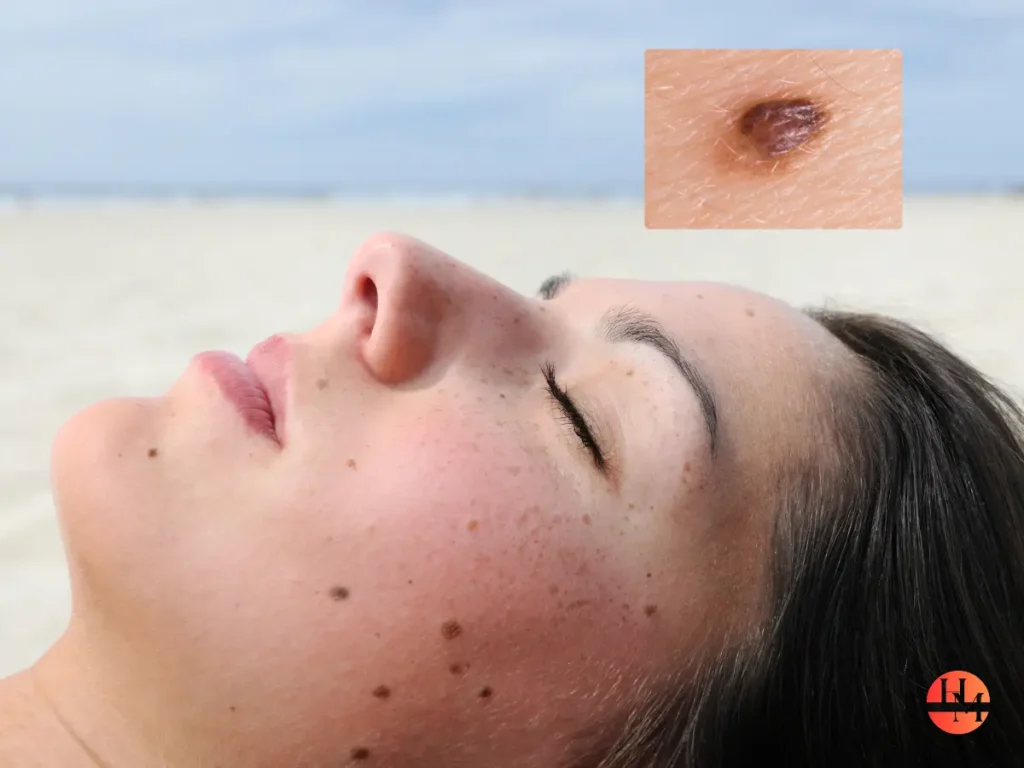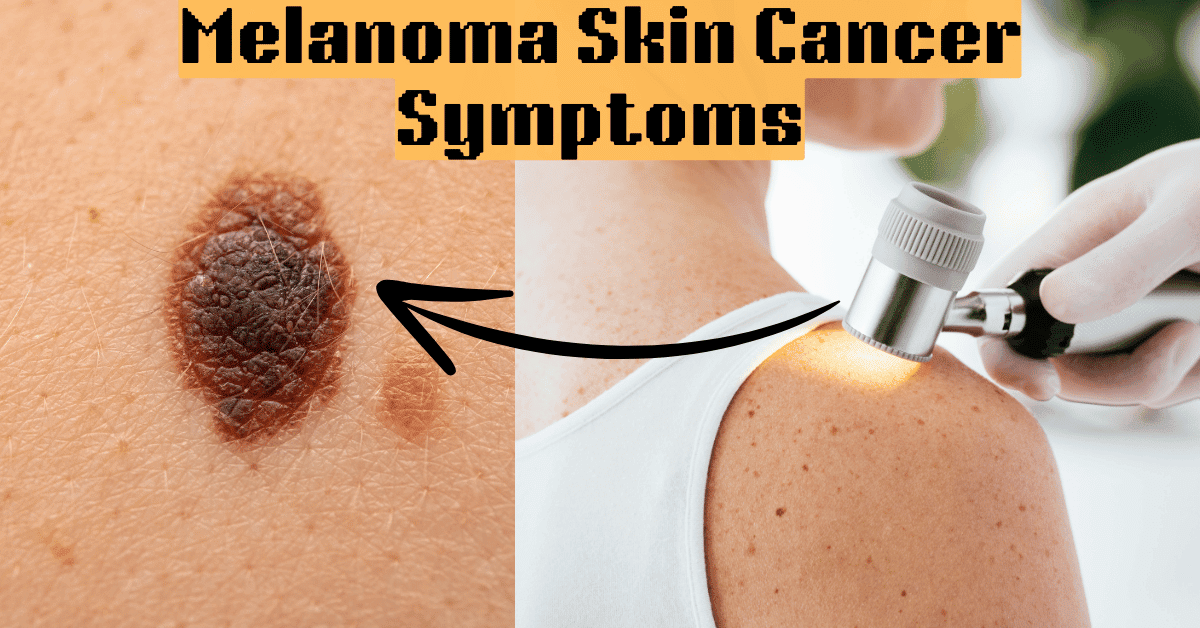Introduction
Melanoma skin cancer symptoms: Melanoma is a serious form of skin cancer that arises from the pigment-producing cells known as melanocytes. While it is less common than other types of skin cancer, melanoma is more dangerous because it is more likely to spread to other parts of the body if not detected early. Early detection is crucial in improving the prognosis and treatment outcomes.
Contents
What is Melanoma?
Melanoma is a type of skin cancer that develops when melanocytes mutate and begin to divide uncontrollably. Unlike non-malignant forms of melanoma, which do not spread, malignant melanoma can metastasize to other parts of the body, making it a potentially life-threatening condition.
Melanoma Skin Cancer Symptoms
The symptoms of melanoma can vary, but they often include changes in the appearance of moles or the development of new pigmented or unusual-looking growths on the skin. Key symptoms include:
- Changes in an existing mole: This is the most common symptom of melanoma. The mole may change in size, shape, or color.
- Development of a new mole: A new mole that is unusual looking or different from your other moles may also be a sign of melanoma.
- Asymmetry: Irregular form of the mole, One half of the mole does not match the other half (uneven growth pattern of the mole).
- Border irregularity: The edges of the mole are uneven, ragged, or blurred.
- Color variation: The mole has more than one color, such as brown, black, tan, red, white, or blue.
- Diameter: The mole is larger than the eraser on a pencil (about 6 millimeters).
- Evolving: The mole continuously changes in size, shape, or color.
- Itching, tenderness, or bleeding: A mole that itches, bleeds, or is tender may be a sign of melanoma.
- A sore that does not heal: A sore on your skin that does not heal within a few weeks may be a sign of melanoma.
Melanoma Moles
Melanoma moles often have distinct characteristics that can help in their identification. The ABCDE rule is a helpful guide for recognizing suspicious moles:

- Asymmetry: If you notice, one half of the mole does not match the other half.
- Border: The edges are uneven, jagged, or fuzzy.
- Color: The color varies and may include shades of brown or black, with patches of pink, red, white, or blue.
- Diameter: Generally, the mole is larger than 6mm (about the size of a pencil eraser).
- Evolving: The mole can change its size, shape, or color.
Stages of Melanoma
Melanoma is classified into stages based on its depth, spread, and other factors. Understanding these stages helps in determining the best treatment approach.
- Stage 0 (Melanoma in Situ): The cancer cells are confined to the outer layer of skin and have not invaded deeper tissues.
- Stage 1: The melanoma is up to 2 mm thick and may or may not be ulcerated. It has not yet spread to lymph nodes or distant sites.
- Stage 2: The melanoma is between 2mm and 4mm thick, or thicker than 4mm, with or without ulceration, but still has not spread to lymph nodes or distant sites.
- Stage 3: The melanoma has spread to one or more nearby lymph nodes or nearby skin or lymphatic channels but not to distant sites.
- Stage 4: The melanoma has spread to distant lymph nodes or other organs such as the lungs, liver, or brain.
Stage 1 Melanoma
Stage 1 melanoma is considered an early stage where the cancer is localized and has not spread to the lymph nodes or distant parts of the body. Symptoms may include a small lesion that may or may not be ulcerated. Treatment for Stage 1 melanoma typically involves surgical removal of the tumor and a margin of surrounding healthy tissue. In some cases, a sentinel lymph node biopsy may be performed to ensure that the cancer has not spread.
Also, read the types of cancer.
Diagnosis of Melanoma
Diagnosing melanoma involves several steps:
- Physical Examination: A dermatologist examines the skin for signs of melanoma.
- Biopsy Procedures: Suspicious moles or growths are removed and examined under a microscope.
- Imaging Tests: In advanced cases, imaging tests such as X-rays, CT scans, or MRIs may be used to determine if the melanoma has spread.
Treatment for Melanoma
The most common treatment options for melanoma depend on the stage and may include the following:
- Surgical Options: Surgery to remove the melanoma and some surrounding healthy tissue is the primary treatment.
- Radiation Therapy: Used to kill cancer cells or shrink tumors.
- Chemotherapy: Uses drugs to kill cancer cells, often used when melanoma has spread.
- Targeted Therapy: This includes drugs that prevent cancer by targeting specific genes or proteins that contribute to cancer growth.
- Immunotherapy: To fight cancer, firstly the body’s immune system is strengthened, which enables the body to fight cancer.
Prevention and Early Detection
Preventing melanoma and catching it early can significantly improve outcomes:
- Sun Protection Tips: Use sunscreen, wear protective clothing, and avoid peak sun hours.
- Regular Skin Checks: Self-examine your skin regularly for new or changing moles.
- Importance of Dermatologist Visits: Regular check-ups with a dermatologist can help in early detection and treatment.
Living with Melanoma
Coping with melanoma involves more than just medical treatment. Emotional and psychological support is crucial. Strategies include:
- Coping Strategies: Counseling, support groups, and stress management techniques can help.
- Support Systems: Family, friends, and cancer support organizations provide essential support.
- Lifestyle Changes: Adopting a healthy lifestyle, including a balanced diet and regular exercise, can aid recovery and improve overall well-being.
Conclusion
Melanoma is a serious but treatable form of skin cancer, especially when detected early. Regular skin checks, sun protection, and prompt medical attention to suspicious moles can make a significant difference. Stay vigilant and proactive in monitoring your skin health.
FAQs,
What are the early signs of melanoma?
Early signs include changes in the size, shape, or color of a mole, as well as the appearance of new growths on the skin.
How can I differentiate between a mole and melanoma?
Use the ABCDE rule: Asymmetry, Border irregularity, Color variation, Diameter larger than 6mm, and Evolving characteristics.
Is melanoma always malignant?
Malignant melanoma is the dangerous form that can spread. There are non-malignant forms, but they are less common and less dangerous.
What is the survival rate for early-stage melanoma?
The survival rate for early-stage melanoma is high, with a five-year survival rate of about 99% for Stage 1 melanoma.
Can melanoma be cured completely?
If detected early, melanoma can often be cured with surgical removal. Advanced stages may require more extensive treatment.
What are melanoma skin cancer symptoms?
Melanoma skin cancer symptoms include changes in moles or new growths, such as asymmetry, irregular borders, uneven color, larger diameter, and evolving size or shape. Other signs may include itchiness, tenderness, or bleeding in affected areas. Early detection is key for better outcomes.


1 thought on “The Melanoma Skin Cancer Symptoms, Stages, and Treatment”